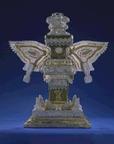 Ideas |
The New ApproachHampton's writings are available on microfilm from the Smithsonian National Museum of American Art.The author used conventions described on the EVMT Project Home Page, conventions developed for use on the Voynich Manuscript. Comments are shown in {braces}. Hampton's English writing on his pages is shown in square brackets surrounded with comment braces {[like this]}. The author numbered the notebook's pages sequentially as they appear in the microfilm, since Hampton's own numbering is inconsistent. Hampton also left loose sheets in Hamptonese. These are of considerable interest, since they include drawings with text in English and Hamptonese. The author called these the P section and numbered them sequentially as P1, P2, etc. as they appear in the microfilm. The microfilm finally shows assortments of loose sheets, Hampton's Bible, and other things in English and Hamptonese. Here again the author called these the X section and numbered them sequentially from the microfilm as X1, X2, etc. The author developed a transcription alphabet for Hamptonese. The transcription alphabet's characters were chosen to resemble Hamptonese symbols as much as possible. A remarkable feature of Hamptonese is those symbols that are a unit constituted of repeated symbols. There is another set of symbols arranged around a diagonal stroke, some including "6" or "9" figures beside the stroke, which we shall call "stroke characters". This transcription alphabet is not yet quite complete, since there are a few other characters on pages not yet transcribed. Here is the table for the transcription alphabet.
Symbols and transcription letters are listed in order of decreasing frequency.
The following software tools, all programs that run under MS-DOS, were used for statistical studies.
|